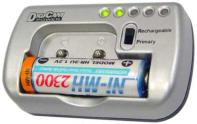It’s a dirty little secret in the retail industry that lots of those items hanging around the check out register isle are often high margin items, i.e. relatively low cost with large mark up. The retailer makes lots of money from those merchandises because they tend to be low-price that people often buy on impulse, e.g. gums, magazines, candies, and batteries. Among all those things, I believe batteries are among the most “obscenely” priced. A typical name-brand (Duracell or Energizer) AA battery can cost as much as $1/each. And sometimes the AAA (smaller) battery can cost more, though they pack less power. Even when you buy them on sale, they can cost as much as $0.40 or even more. The fact is that you can easily stock up on generic brand batteries like Ultrablast and save lots of money. As long as they are Alkaline batteries, they last about the same time, according to Consumer Report and my experience. Even if they don’t last as long, you end up saving big money anyway. For example, I bought 2 cases (quantity of 100) of Ultralast AA batteries at Fry’s during a sale last year that cost me only $0.10/each. Just compare to the name brand that costs 4x or more but don’t last 4x longer. Even at $0.20/each, the regular price at Fry’s, they are still a good deal. For AAA batteries, you may want to go to eBay and buy them from the wholesaler by searching for “AAA wholesale.” Because AAA batteries are light weight (low shipment cost), they often are a good deal when shipment cost are included provided you buy them from the wholesaler. My recent eBay search turned up $0.16/ea at lot of 100 and $0.11/ea at lot of 300. Of course, you don’t want to buy too many as the stored charge gets depleted through time. But buying enough to last 2 years at one time should be just fine. I usually buy a batchof 100~200 since I have a toddler, whose toys need to be kept alive with lots of batteries!
Sometimes, it’s more cost effective to buy the rechargeable NiMh batteries depending on how long the battery would last. The recent development on NiMh has turned out very high-charged batteries (up to 2900mAH on AA size). A slow-drain remote control or small-size MP3 player may work better with Alkaline batteries, because it drains the batteries very slowly and you don’t need to contend with the self-discharge of the rechargeable batteries that require frequent re-charges, which is a nuisance and may not be too cost effective if you cannot and don’t plan to use the NiMh more than 20 times within 3 years, because of NiMh costs roughly 20x ~ 40x of an Alkaline battery and they usually don’t last more than 3~5 years, retaining less charge after each re-charge. I’ll have a separate tip on NiMh later.
I also recommend highly that you invest on a
DigiCam battery tester. This thing will pay for itself within a year, allowing you to keep the good batteries and discard the bad ones. The beauty of this thing is that it’s a no brainer and it tells you what you need to know right away: 0% (dead), 20%, 40%, 60%, 80% or 100% charged.

Also, please make sure the dead batteries are recycled. They’re not easily digestible by our landfills due to its toxic contents. Most garbage companies would gladly take them back on a separate bag during garbage collection. I keep a bone pile of dead batteries in a drawer and recycle them when it’s full. It’s good for the environment and gives you a sense of accomplishment (due to the saving).
So my money saving tip: Stock up on Alkaline batteries and save!
